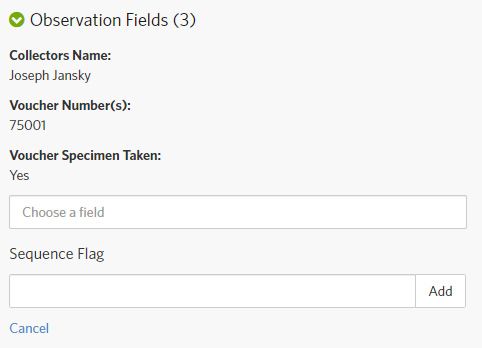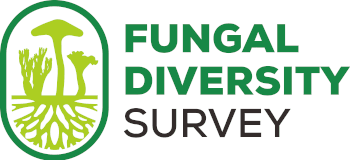MycoBlitz Selection Committee Training
Over 20 regional and taxonomic identifiers will be working to put names on specimens from the 2019 Continental MycoBlitz during the week of August 12-19, 2019. As the project is being hosted on iNaturalist, anyone can serve to offer identifications on the observations that are posted. This guide is intended to aid the selection committee, but all mycoblitz participants can assist.
Accessing the Observations
The project for the event is located here:
The front page of the project will look similar to this. Clicking the "Observations>>" link on the top left will take you to the observation explorer view.
From this view, you can quickly search for specific locations and/or taxa if you have a specific geographic or taxonomic focus.

It may be easist to open each observation in a new window, rather than clicking back and forth between this screen.
Creating an Identification
Below the images on an observation, you will find the area to "Suggest an Identification." Enter your suggested species name in this field. You can also enter any commentary you have about your identification.

Occasionally, the species name you would like to enter may not be in the iNaturalist database. This will be especially true for identifications to taxonomic levels other than genus or species. Ex - Amanita sect. Vaginatae. This would also be the place for provisional names such as Amanita cyclops. On the right hand side of the observational page you will see a section called "Observational Fields." Utilize the "Mycoflora Species Name" field to include names that are not listed in the iNaturalist database.


Occasionally, the species name you would like to enter may not be in the iNaturalist database. This will be especially true for identifications to taxonomic levels other than genus or species. Ex - Amanita sect. Vaginatae. This would also be the place for provisional names such as Amanita cyclops. On the right hand side of the observational page you will see a section called "Observational Fields." Utilize the "Mycoflora Species Name" field to include names that are not listed in the iNaturalist database.

Considerations for Identification
- Never feel compelled to offer an identification if you are not sure of the taxon. We have enough identifiers that someone else is likely to come along and offer an identification on the specimen.
- Feel free to only make identifications to genus. If there are leftover sequencing spots, we may come back though the project and search for Inocybe (or a similar group in dire need to revision) to fill the remaining spots. However, if the observations have not at least been identified to genus, we will not be able to conduct the search efficiently.
- You can always ask for the individual to provide more information that can help with the identification. Just include the information request in the comments below the image. Common requests may include smell, taste, or photos from additional angles.
Flagging Specimens for Sequencing
As an identifier for this foray, you have the ability to flag individual specimens for sequencing. The "Voucher Specimen Taken" observational field will tell you if a specimen was saved by the participant. Even if the specimen was not saved, feel free to flag the observation, as the individual may be in a position to return to the site and make the collection.
Specimens flagged for sequencing should have one or more of the following charactaristics:

We ask that only registered identifiers utilize this field.
Do not worry about over/under flagging specimens during the week of the event. Feel free to flag as many or as few as you believe to be worthy for sequencing.
Participants can send in any ten specimens they would like for consideration to be sequenced. They are not required to only send specimens that have been flagged. Once the specimens arrive at our sorting facility, the flagged specimens will have the priority during the tissue collection process. If there are remaining sequencing spots once most of the specimens have arrived at the sorting facility, we may return to you to select additional specimens for tissue collection.
Specimens flagged for sequencing should have one or more of the following charactaristics:
- Be one of the four target taxonomic groups for this event: Cortinarius, Inocybe, Amanita sect. Vaginatae, and the Marasmiaceae.
- Be a rare or uncommon species.
- Have unusual or interesting morphological characters, based on your expertise.
- Have particularly nice documentation - great photographs, additional descriptions, metadata, etc.
- Is a member of a known species group.
- Be from a region with few historic collections. Think the Great Plains (Kansas, Nebraska, etc) or the south (Mississippi, Alabama, etc.).
- For species/groups with a tough flesh, such as polypores, only flag specimens for sequencing that are very unusual.

We ask that only registered identifiers utilize this field.
Do not worry about over/under flagging specimens during the week of the event. Feel free to flag as many or as few as you believe to be worthy for sequencing.
Participants can send in any ten specimens they would like for consideration to be sequenced. They are not required to only send specimens that have been flagged. Once the specimens arrive at our sorting facility, the flagged specimens will have the priority during the tissue collection process. If there are remaining sequencing spots once most of the specimens have arrived at the sorting facility, we may return to you to select additional specimens for tissue collection.
Advanced Observational Filtering
The iNaturalist project has a corresponding project on MycoMap. This allows for more detailed filtering of observations that have come in to the event. As an identifier for the foray, you have the option to access this dashboard to help sort/filter observations. Anyone can access this project, but functionality will be limited for anyone who is not an identifier for the event.
A couple of additional filtering options are available from the MycoMap dashboard.
The MycoMap dashboard will be primarily used for sequence analysis, but may serve helpful to identifiers who are focused on certain taxonomic groups.
A couple of additional filtering options are available from the MycoMap dashboard.
- Ability to sort observations by local, regional, or continental "Importance Factor."
- Ability to sort observations by taxonomic names that were not included in the iNaturalist database. Ex - show all Amanita sect. Vaginatae observations.
- Ability to quickly filter by observations that have a specimen.
- Quickly filter by specimens that have been flagged for sequencing.
The MycoMap dashboard will be primarily used for sequence analysis, but may serve helpful to identifiers who are focused on certain taxonomic groups.
Selection Committee Overview
- The key task is to make preliminary identifications of the observations that are posted to the project during the week of the event.
- The secondary task is to flag the most interesting observations you encounter for sequencing utilizing the "Sequencing Flag" observational field. Try to flag around 50-100 specimens during the week of the event.
- If you need to utilize an epithet that is not in the iNaturalist database, place your identification in the "Mycoflora Species Name" observational field.
- Email steve@mycomap.com if you have any questions during the event.
Post-event Analysis
The in-depth assessments begin once the specimens arrive at the herbarium. The specimens are checked to ensure they are dried properly, they match the observation, the metadata is complete, there are good images, etc. That is the initial triage step. Next every collection is assessed based on the total number of specimens deposited in herbaria for the species and the total number of sequences. This is assessed on the national, regional, and local level. The final specimens that are selected will be from the list of target taxa, flags from the identification team, and selections based on the objective data of taxa that already have sequences and collections.


